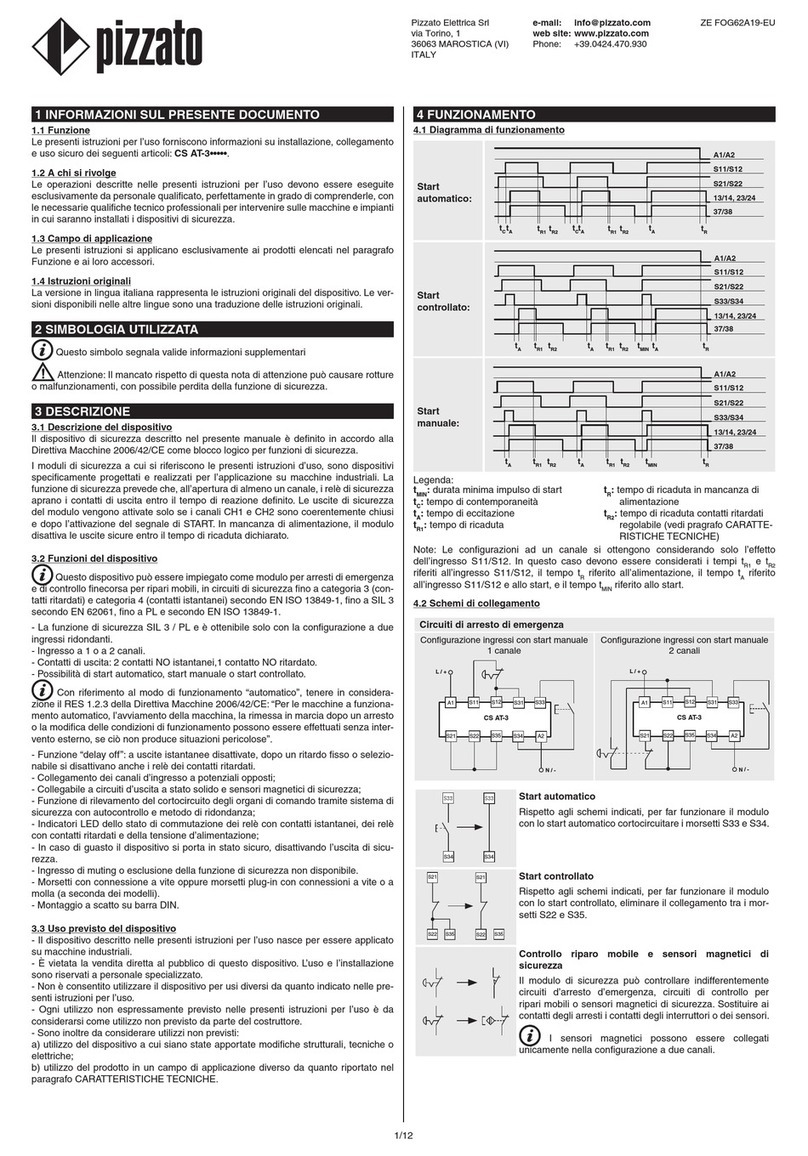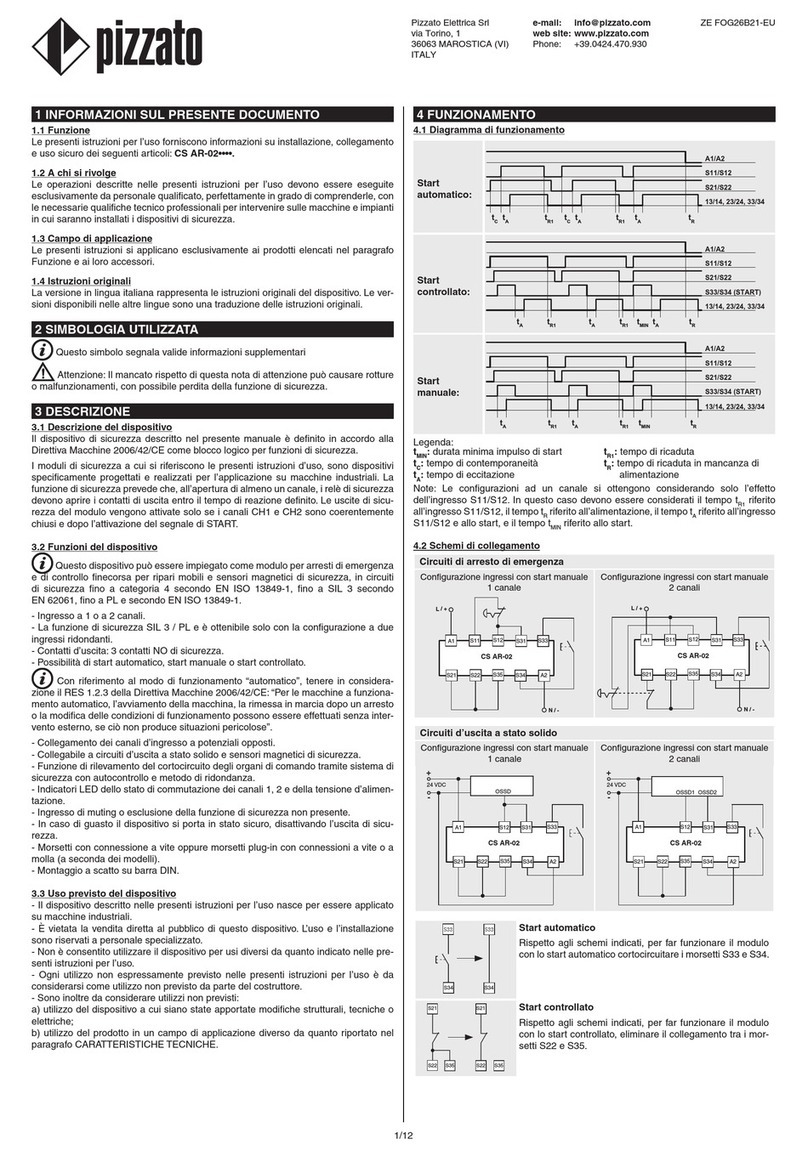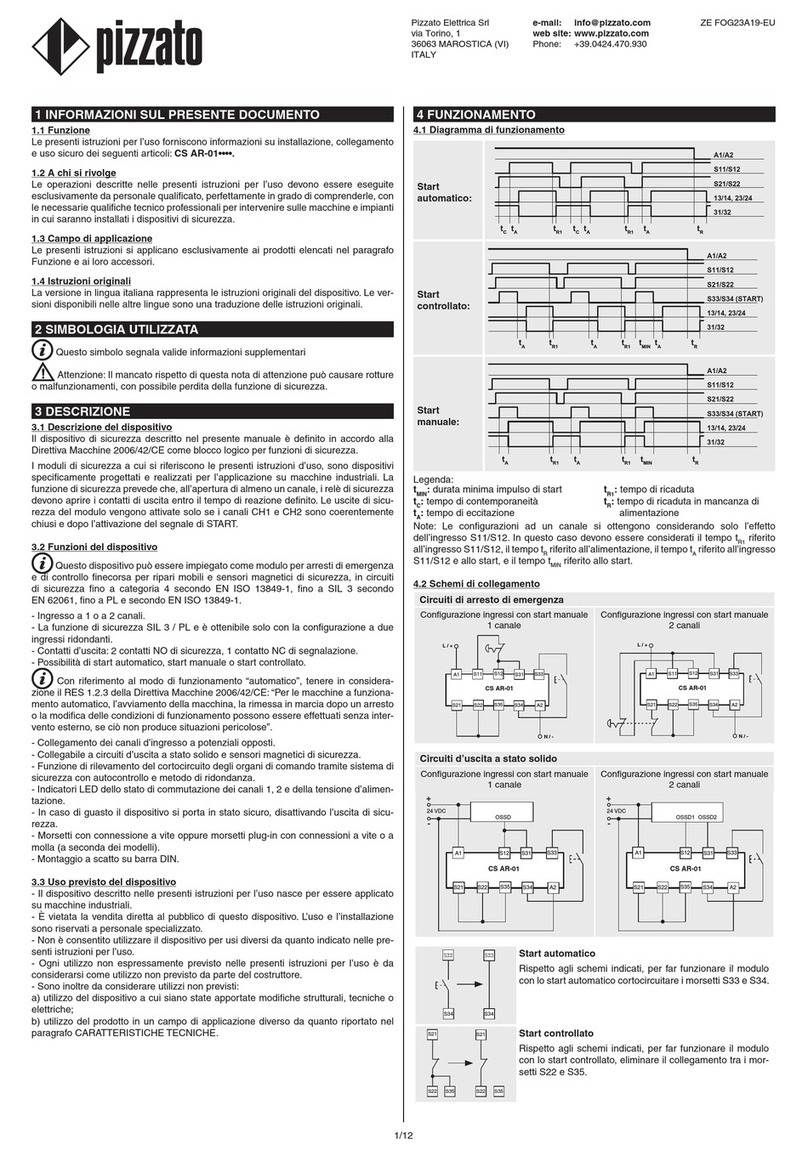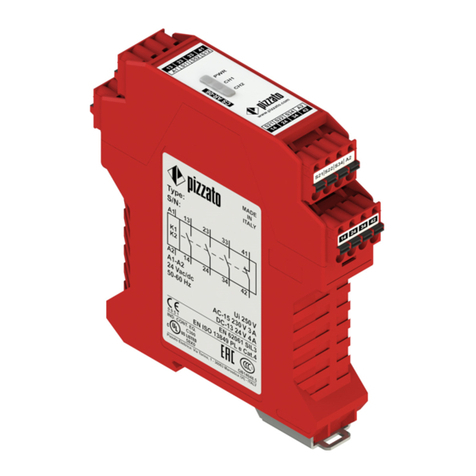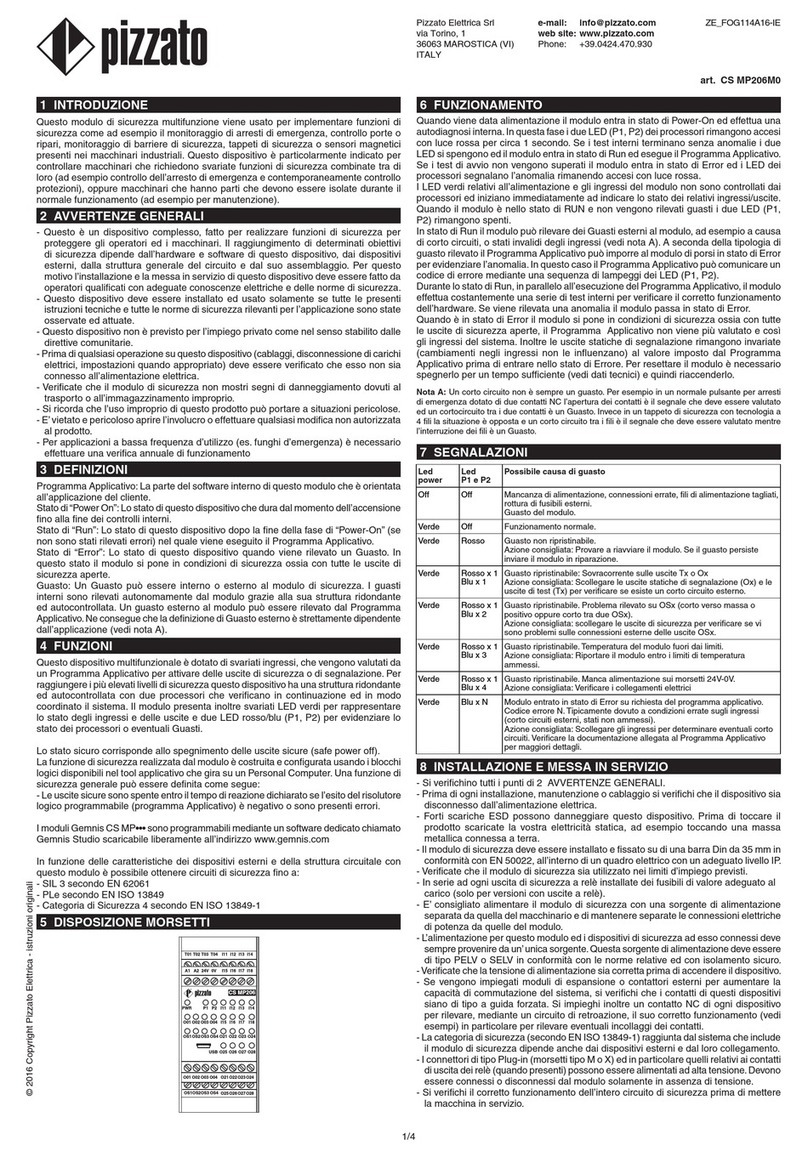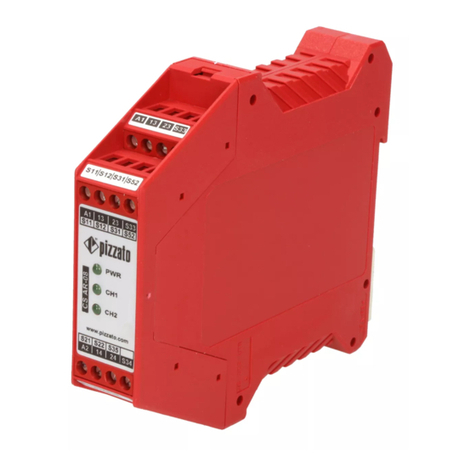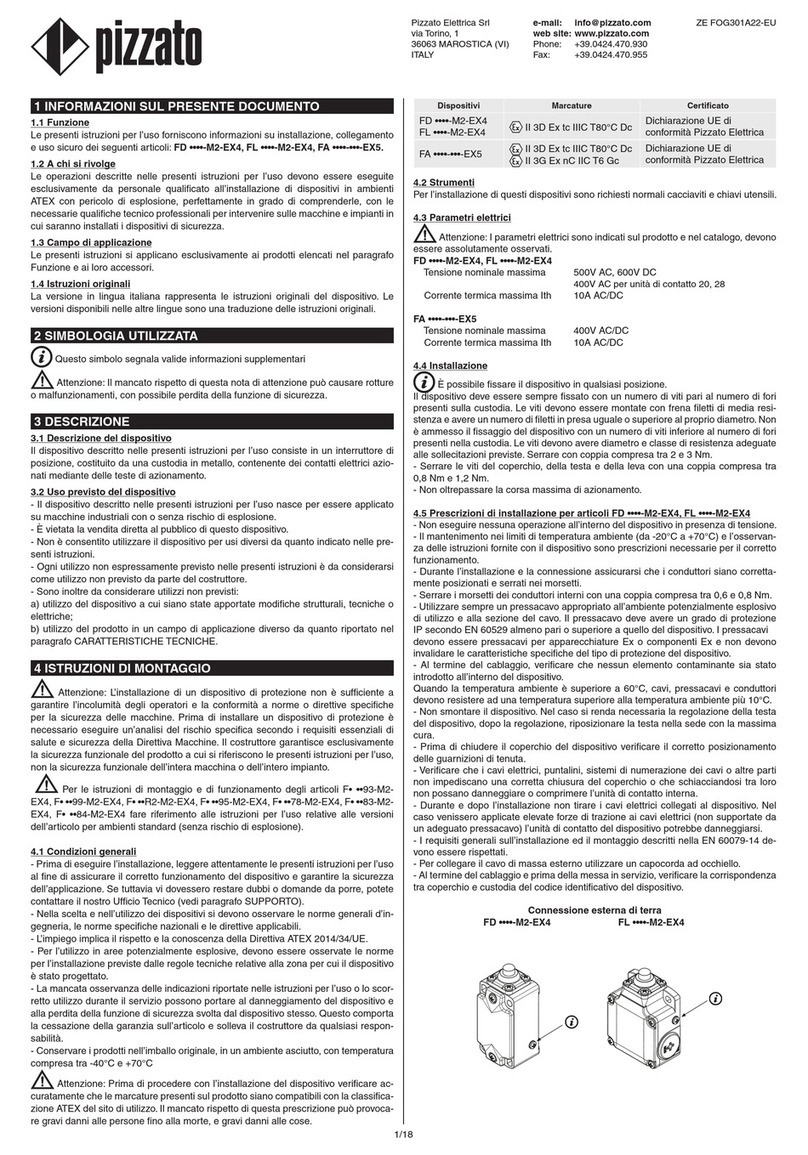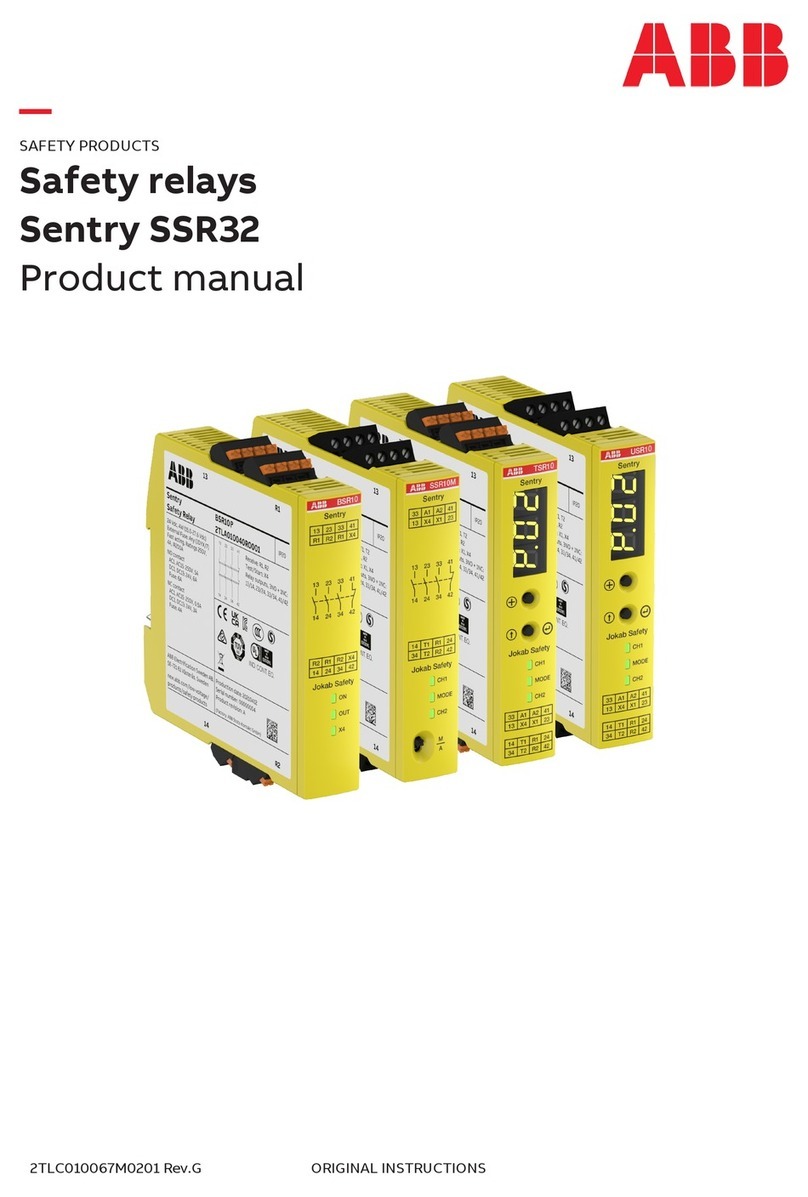
9/12
métallique reliée à la terre. De fortes décharges électrostatiques risquent d'endom-
mager le dispositif.
- Alimenter le module de sécurité et les autres dispositifs qui y sont reliés depuis une
source unique du type SELV et conforme aux normes pertinentes (applicable unique-
ment aux versions ayant une tension d'alimentation de 12 et 24 V).
- Il est recommandé de séparer galvaniquement l'alimentation du module de sécurité
de la partie puissance de la machine et de poser les câbles de raccordement du
module séparément des câbles pour l'alimentation des charges de puissance.
- Toujours brancher le fusible de protection (ou tout dispositif équivalent) en série sur
l'alimentation pour chaque dispositif.
- Toujours brancher le fusible de protection (ou tout dispositif équivalent) en série sur
les contacts électriques de sécurité.
- Durant et après l'installation, ne pas tirer sur les câbles électriques qui sont reliés
au dispositif. Si des forces de traction trop élevées sont appliquées sur les câbles
électriques le dispositif risque d'être endommagé.
7.5 Prescriptions supplémentaires pour les applications de sécurité ayant des
fonctions de protection des personnes
Toutes les prescriptions précédentes étant bien entendues, il faut également respec-
ter les prescriptions supplémentaires suivantes lorsque les dispositifs sont destinés à
la protection des personnes.
- L’utilisation implique le respect et la connaissance des normes EN ISO 13849-1,
EN 62061, EN 60204-1, EN ISO 12100.
- Dans l'analyse des risques, tenir compte du fait qu'en mode de démarrage manuel
un éventuel collage du bouton de démarrage peut entraîner l'activation immédiate
du module.
- En cas d'utilisation de modules d'extension ou de contacteurs externes, s'assurer
qu'ils ont des contacts à guidage forcé et connecter en rétroaction un contact NC de
chaque dispositif.
7.6 Limites d’utilisation
- Utiliser le dispositif selon les instructions, en observant ses limites de fonctionne-
ment et conformément aux normes de sécurité en vigueur.
- Les dispositifs ont des limites d'application spécifiques (température ambiante, mini-
male et maximale, courants maximums, degré de protection IP, etc.) Les dispositifs
satisfont à ces limites uniquement lorsqu'ils sont considérés individuellement et non
combinés entre eux.
- Cet appareil n'est pas destiné à un usage privé tel que défini par les directives
européennes.
- La responsabilité du fabricant est exclue en cas de :
1) Utilisation non conforme.
2) Non-respect des présentes instructions ou des réglementations en vigueur.
3) Montage réalisé par des personnes non spécialisées et non autorisées.
4) Omission des tests fonctionnels.
- Dans les cas d'application énumérés ci-après, avant toute installation, contacter
l'assistance (voir paragraphe SUPPORT) :
a) dans les centrales nucléaires, les trains, les avions, les voitures, les incinérateurs,
les dispositifs médicaux ou toute autre application dans laquelle la sécurité de deux
personnes ou plus dépend du bon fonctionnement du dispositif.
b) cas non mentionnés dans le présent manuel.
8 MARQUAGES
Le dispositif présente un marquage, placé à l'extérieur de manière visible. Le mar-
quage comprend :
- Marque du fabricant
- Code du produit
- Numéro de lot et date de fabrication. Exemple : CS1-123456 (A19). La dernière
lettre du lot indique le mois de fabrication (A = janvier, B = février, etc.) et l'année de
fabrication (19 = 2019, 20 = 2020, etc.).
9 CARACTÉRISTIQUES TECHNIQUES
9.1 Boîtier
Matériau : Polyamide PA 66, autoextinguible V0 selon UL 94
Degré de protection : IP40 (boîtier), IP20 (bornier)
Section des câbles : 0,2 … 2,5 mm2 (24 … 12 AWG)
Couple de serrage des bornes : 0,5 … 0,6 Nm
9.2 Données générales
SIL (SIL CL) : jusqu'à SIL CL 3 selon EN 62061
Niveau de performance (PL) : jusqu'à PL e selon EN ISO 13849-1
Catégorie de sécurité : jusqu'à cat. 4 selon EN ISO 13849-1
MTTFD: 111 ans
DC : High
PFHD: 7,56 E-10
Durée de vie : 20 ans
Température ambiante : -25°C ... +55°C
Température de stockage : -25°C … +70°C
Durée mécanique : > 10 millions de cycles de fonctionnement
Durée électrique : > 100.000 cycles de fonctionnement
Degré de pollution : externe 3, interne 2
Tension à impulsion Uimp : 4 kV
Tension nominale d’isolement Ui: 250 V
Catégorie de surtension : II
Distances dans l'air et superficielles : selon EN 60947-1
9.3 Alimentation
Tension d'alimentation nominale (Un) : 24 Vac/dc ; 50 … 60 Hz
Tolérance sur la tension d'alimentation : ±15% d'Un
Ondulation résiduelle max. DC : 10%
Absorption AC : < 5 VA
Absorption DC : < 2 W
9.4 Circuit de contrôle
Protection contre les courts-circuits : résistance PTC, Ih = 0,5 A
Temps de la PTC : déclenchement > 100 ms, réarmement > 3 s
Résistance maximale par entrée : ≤50 Ω
Courant par entrée : < 30 mA
Durée min. impulsion de démarrage tMIN : > 100 ms
Temps d’excitation tA: < 70 ms
Temps de retombée tR1 : < 40 ms
Temps de retombée
en absence d'alimentation tR: < 80 ms
Temps de synchronisme tC: infini
9.5 Circuit de sortie
Contacts de sortie : 4 contacts NO de sécurité
1 contact NC de signalisation
Type de contacts : forcé
Matériau des contacts : alliage d’argent plaqué or
Tension maximale commutable : 230/240 Vac ; 300 Vdc
Courant maximal par branche : 6 A
Courant thermique à l’air libre Ith : 6 A
Somme maximale des courants ΣIth2: 72 A2
Courant minimal : 10 mA
Résistance des contacts : ≤100 mΩ
Fusible de protection externe : 4 A
Charge maximale commutable : 1380 VA/W
Catégories d’utilisation selon EN 60947-5-1 :
AC15 (50 … 60 Hz) Ue = 230 V, Ie = 3 A
Dc13 (6 cycles de fonctionnement/minute) Ue = 24 V, Ie = 4 A
Catégorie d’utilisation selon UL 508 : C300
9.6 Conformité aux normes
EN 60204-1, EN ISO 13855, EN ISO 14118, EN ISO 12100, EN ISO 13850,
EN 60529, EN 61000-6-2, EN 61000-6-3, EN 61326-1, EN 60664-1, EN 60947-1,
EN IEC 63000, EN ISO 13849-1, EN ISO 13849-2, EN 62061, UL 508, CSA C22.2 n°
14, GB/T14048.5-2017
9.7 Conformité aux directives
Directive Machines 2006/42/CE, Directive Compatibilité électromagnétique 2014/30/
UE, Directive RoHS 2011/65/UE.
10 VERSIONS SPÉCIALES SUR DEMANDE
Des versions spéciales du dispositif sont disponibles sur demande.
Ces versions spéciales peuvent différer sensiblement des versions décrites dans le
présente mode d'emploi.
L'installateur doit s'assurer qu'il a bien reçu (voir paragraphe SUPPORT) toutes les
informations écrites concernant l'utilisation de la version spéciale demandée.
11 ÉLIMINATION
Le produit doit être éliminé de manière appropriée à la fin de sa durée de vie,
selon les règles en vigueur dans le pays où il est démantelé.
12 SUPPORT
Le dispositif peut être utilisé pour garantir la sécurité physique des personnes ; par
conséquent, s'il existe un doute quelconque concernant son installation ou son
utilisation, toujours contacter notre support technique :
Pizzato Elettrica srl
Via Torino, 1 - 36063 Marostica (VI) - ITALIE
Téléphone +39.0424.470.930
E-mail tech@pizzato.com
www.pizzato.com
Notre support technique est assuré dans les langues italienne et anglaise.
13 DÉCLARATION CE DE CONFORMITÉ
Le soussigné, représentant le fabricant suivant :
Pizzato Elettrica Srl, Via Torino, 1 - 36063 Marostica (VI) - Italie
déclare ci-après que le produit est conforme aux dispositions de la Directive machines
2006/42/CE. La version complète de la déclaration de conformité est disponible sur
le site www.pizzato.com
Marco Pizzato
AVIS DE NON-RESPONSABILITÉ :
Sous réserve d'erreurs et de modifications sans préavis.Les données présentées dans ce document
sont soigneusement contrôlées et constituent des valeurs typiques de la production en série. Les
descriptions du dispositif et de ses applications, les contextes d'utilisation, les détails sur les
contrôles externes, les informations sur l'installation et le fonctionnement sont fournis conformément
à nos connaissances.Toutefois, cela ne signifie pas que les caractéristiques décrites impliquent des
responsabilités juridiques allant au-delà des « Conditions Générales de Vente » comme indiquées
dans le catalogue général de Pizzato Elettrica. Le client/utilisateur n'est pas dispensé de l'obligation
d'examiner les informations, les recommandations et les réglementations techniques pertinentes
avant d'utiliser les produits à leurs propres fins. Étant donné les multiples possibilités d'application
et de connexion du dispositif, les exemples et les schémas contenus dans le présent manuel sont
purement descriptifs ; l'utilisateur est tenu de s'assurer que l'application du dispositif est bien
conforme à la réglementation locale. Toute reproduction, même partielle, du présent manuel, sans
une autorisation écrite de Pizzato Elettrica, est interdite.
© 2019 Copyright Pizzato Elettrica. Tous droits réservés.
